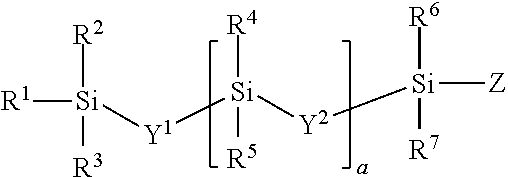Siloxane monomers containing hydrolysis resistance carbosiloxane linkage, process for their preparation and thin films containing the same for contact lens application
a technology of hydrolysis resistance and carbosiloxane, which is applied in the field of monoacrylate functional silicone monomers, can solve the problems of reducing the amount of oxygen transported to the cornea, restricting their use, eye irritation, etc., and achieves the effect of inherently wettable and better oxygen permeability
- Summary
- Abstract
- Description
- Claims
- Application Information
AI Technical Summary
Benefits of technology
Problems solved by technology
Method used
Image
Examples
example 1 (
Ex. 1)
Synthesis of Compound Represented by the Formula
[0054]
[0055]This monomer was prepared using two-step process. In the first step, a hydrosilylation reaction occurs between hydroxyl terminated methallyl polyether and mono-hydride functional carbosiloxane. In the second step, the hydroxyl group is converted into polymerizable methacrylate group through a methacrylation reaction. The mono-hydride functional carbosiloxane was prepared using the process disclosed in U.S. Pat. No. 7,259,220 B1, which is herein incorporated in its entirety by reference.
[0056]In a specific process, 1-(2-trimethylsilylethyl)-1,1,3,3-tetramethyldisiloxane (25 g), a hydride functional carbosiloxane, and a methallyl-terminated polyethylene glycol (46 g), having an average of 8 ethylene oxide (EO) units in the chain, were introduced into 250 mL three-neck round bottom (RB) flask equipped with a reflux condenser, mechanical stirrer, temperature controller with thermocouple and a nitrogen inlet. The contents ...
example 2 (
Ex. 2)
Synthesis of Compound Represented by the Formula
[0062]
[0063]This monomer was prepared was also prepared using two-step process. In the first step, a hydrosilylation reaction occurs between hydride functional carbosiloxane and vinyl functional cyclohexene epoxide. In the second step, the epoxide group is reacted with unsaturated acids to introduce polymerizable group in it.
[0064]In a specific process, 1-(2-trimethylsilylethyl)-1,1,3,3-tetramethyldisiloxane (25 g) and vinyl cyclohexene epoxide (13.2 g) were introduced into 250 mL three-neck round bottom (RB) flask equipped with a reflux condenser, mechanical stirrer, temperature controller with thermocouple and a nitrogen inlet. The contents were heated to 80° C. to 90° C. in presence of Karstedt's catalyst (10 to 50 ppm Pt with respect to total reactant charge) and buffer (U.S. Pat. No. 5,986,122) to prevent side reactions like dehydrocoupling reaction from taking place. After completion of the hydrosilylation, distilling out u...
example 3 (
Ex. 3)
[0068]The compound obtained in Example 1 (49 parts by weight), 2-hydroxy ethyl methacrylate (49 parts by weight), ethylene glycol dimethacrylate (EGDMA) (1 part by weight), and benzoyl peroxide (1 part by weight) were mixed and stirred. The resulting clear, homogeneous and transparent reaction mixture was purged with nitrogen gas and poured into a polyethylene terephthalate mould. The thin film of the reaction mixture was thermally cured using hot air oven at 85° C. for 8 hours. After curing, heating the film in 10% isopropyl alcohol (IPA), in deionized (DI) water, released it from the mould and purified from the leachables. The film was further washed with hot DI water. The final silicone hydrogel film thus produced was soft, flexible and transparent and stored in DI water and measured for some of the contact lens properties. Table 1 shows the details of the formulation and the properties of the silicone hydrogel films produced.
PUM
| Property | Measurement | Unit |
|---|---|---|
| hydrophilic | aaaaa | aaaaa |
| hydrophobic | aaaaa | aaaaa |
| transparent | aaaaa | aaaaa |
Abstract
Description
Claims
Application Information
 Login to View More
Login to View More - R&D
- Intellectual Property
- Life Sciences
- Materials
- Tech Scout
- Unparalleled Data Quality
- Higher Quality Content
- 60% Fewer Hallucinations
Browse by: Latest US Patents, China's latest patents, Technical Efficacy Thesaurus, Application Domain, Technology Topic, Popular Technical Reports.
© 2025 PatSnap. All rights reserved.Legal|Privacy policy|Modern Slavery Act Transparency Statement|Sitemap|About US| Contact US: help@patsnap.com



